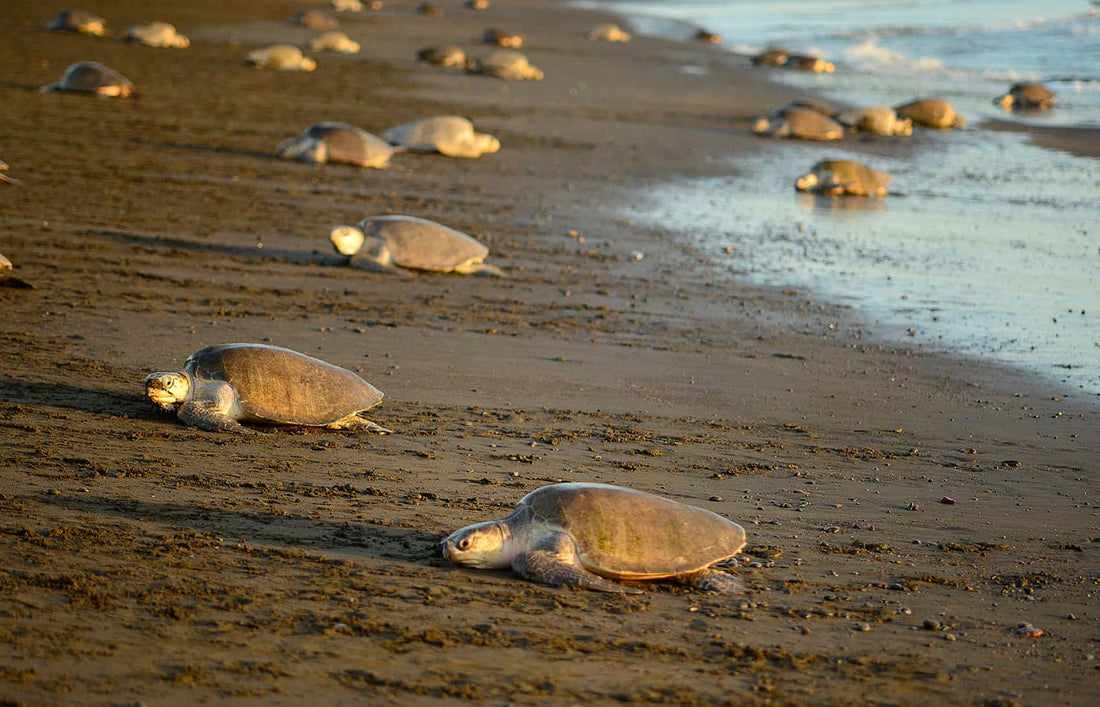
Costa Rican Sea Turtles: From Hatchling to Adulthood
Share
Did you know that only one in every 1,000 sea turtle hatchlings makes it to adulthood? This fact shows how tough the journey is for Costa Rican sea turtles. They start on the beaches of this beautiful country. Five out of seven sea turtle species live in Costa Rica, including the leatherback, loggerhead, green, hawksbill, and olive ridley turtles. These turtles are key to the area's ecosystem.
The sea turtles' journey is both amazing and dangerous. It starts when female turtles lay their eggs on the beach. After 60 days, the hatchlings come out and face many dangers to reach the ocean. This early stage is very important because many hatchlings don't make it due to predators or human actions. Learning about their journey highlights why we must protect Costa Rica's wildlife and their homes.

The Importance of Costa Rican Sea Turtles
Costa Rican sea turtles are key to healthy marine ecosystems. They help keep seagrass beds and coral reefs healthy by eating seagrass. This eating helps seagrass grow and supports many other sea creatures.
Without endangered sea turtles, the ocean's balance is upset. They are important to the food web. Their loss affects many other sea animals and the ocean's health.
Costa Rica is home to the biggest green turtle rookery in the Western Hemisphere. It also has two olive ridley beaches where turtles nest. These places attract many tourists, helping the local economy and conservation.
But, sea turtles face many dangers. People take their eggs, hunt them for meat and oil, and get caught in fishing gear. Thousands die each year from fishing nets, showing we need to act fast to save them.
Costa Rica is working hard to protect its sea turtles. It has made 27 national parks, covering over 25% of its land. These parks help keep sea turtles safe and show Costa Rica's commitment to its marine life.
| Threats to Sea Turtles | Conservation Efforts |
|---|---|
| Illegal egg extraction | Protection of beaches |
| Slaughter for meat and oil | Participation in CITES |
| Bycatch in fisheries | Establishment of national parks |
| Climate change impacts | Regulation of trade to prevent endangerment |
Understanding The Lifecycle of Costa Rican Sea Turtles
The sea turtle lifecycle includes important stages: egg, hatchling, juvenile, and adult. Female sea turtles return to their birth beaches to lay eggs, a behavior known as natal homing. They lay about 80 to 120 eggs, which take around 60 days to incubate.
The sand's temperature during incubation affects the hatchlings' sex. Cooler sand makes more males, while warmer sand makes more females.
After hatching, the tiny hatchlings face many challenges. They swim miles offshore, avoiding predators and dangers. Sadly, only about 1 in 1,000 hatchlings makes it to adulthood.
These early stages are tough due to high predation and limited resources. But, hatchlings that survive find food in the Gulf Stream currents. This helps them avoid predators and continue their journey.
These migrations are key to their survival. By understanding their lifecycle, we can better protect them. With threats like habitat loss and climate change, saving Costa Rican sea turtles is crucial for the environment.
Turtle Nesting Season: A Magical Time
The turtle nesting season in Costa Rica is a special event that happens from April to November. It's a time when nature lovers can see different turtle species come to the beaches to nest. Female sea turtles, like the endangered Leatherback and Olive Ridley, come at night to nest. This helps them avoid predators and the sun.
At one nesting, a female can lay 80 to 200 eggs. These eggs are carefully placed in a hole. Places like Tortuguero National Park and Ostional Wildlife Refuge are great spots to see this. The Olive Ridley turtles are known for their big nesting events called arribadas, which happen a few days before the new moon.
As the sun sets, the turtles start nesting. This shows the beauty of nature and the work to protect these turtles. We need to spread the word about the dangers they face, like poaching and losing their homes. This helps ensure they can survive for a long time.
| Sea Turtle Species | Nesting Period | Nesting Beaches |
|---|---|---|
| Leatherback Sea Turtle | March - November | Las Baulas National Marine Park |
| Hawksbill Sea Turtle | April - November | Coral reefs and remote beaches |
| Atlantic Green Sea Turtle | April - November | Tortuguero National Park |
| Loggerhead Sea Turtle | April - November | Pacific Coast |
| Olive Ridley Sea Turtle | August - November (high activity) | Ostional Wildlife Refuge |
Being part of the turtle nesting season helps us learn more about these amazing creatures and why we need to protect them. Each season reminds us of the beauty and vulnerability of marine life. It encourages us to help in the conservation of these incredible sea turtles.
The Turtle Hatching Process
The turtle hatching process is a key moment in their lives. It's when they begin their journey to adulthood. As they near the end of their incubation, hatchlings use a special tooth called a caruncle to escape their eggs. This happens together in the nest, helping them during this important time.
Most hatchings happen at night, a smart move to avoid predators. Once out, the tiny turtles head straight for the ocean, following their instincts. But, this first step is very dangerous. Only about 1 in 1,000 hatchlings make it to adulthood because of threats from crabs, birds, and other predators.
In Costa Rica, there are many places where turtles nest all year round. A special spot, the Ostional National Wildlife Refuge, sees thousands of Olive Ridley turtles nest together. This event, called an arribada, shows how sea turtles protect their young, helping them start their tough journey from land to sea.
Hatchling Journey: Into the Ocean
Sea turtle hatchlings start their ocean journey with a frantic swim that can last days. They use the yolk for energy to move towards deeper waters. This is where they find safety from predators. Sadly, only about 1 in 1,000 turtles makes it to adulthood, showing the dangers they face.
When they hit the water, hatchlings follow natural signs like the beach slope and wave crests. This helps them avoid dangers like ghost crabs, birds, and fish. The importance of safe marine habitats is clear as they face these dangers.
This phase shows how vital marine conservation in Costa Rica is. Rising temperatures can affect turtle populations by changing the sex ratio. This could impact future breeding. Groups like SEE Turtles work to protect hatchlings and help marine conservation in Costa Rica.
Learning about hatchlings' challenges highlights the need to protect their habitats. During the "lost years," their whereabouts are unknown for up to a decade. Every moment in safe environments is crucial for their survival.
The “Lost Years” of Sea Turtles
The term "lost years of sea turtles" talks about a key and mysterious part of their life. This phase goes from when they leave the hatchling stage until they come back as juveniles. It can last from one to ten years and is still a puzzle for researchers. During this time, sea turtles face many dangers and changes in their environment.
It's hard to understand what sea turtles do during this time because they live in far-off places. Researchers are doing exciting studies, like those in Ecuador, on hawksbill hatchlings. In 2016, they put acoustic transmitters on 52 hawksbill hatchlings, each under 2 grams, to track their early ocean trips. These young turtles showed a lot of activity, swimming from a few meters to 2 kilometers away from where they started, trying to keep a straight path.
Even though the lost years of sea turtles are still a bit of a mystery, tracking technology helps us learn more about their travels. For example, one hawksbill turtle traveled over 2,000 kilometers, going through several countries like Ecuador, Colombia, Panama, and Costa Rica.
Teams from different organizations are working together to learn more about these mysterious creatures. They found that sea turtles from Ecuador have their own unique DNA, showing they don't mix much with turtles from the north, which makes us wonder about their movements.
Loggerhead sea turtles from the southeastern coast of the United States also have their own story of the lost years. These hatchlings vanish from the western Atlantic for a few years, then show up in coastal areas, about 20 inches wide. They travel a long way, over 3,700 miles, to get to their feeding grounds in the eastern Atlantic and the Mediterranean Sea. Tracking these turtles helps scientists understand their paths and behaviors during the lost years.
Studying these secret years is key for saving these turtles. As scientists keep tracking and studying sea turtles, we'll learn more about their lives. The journey starts with hatchlings, but what happens in the lost years is crucial for their future.
| Sea Turtle Species | Key Findings |
|---|---|
| Hawksbill | Movements tracked over long distances; significant travel to various countries. |
| Loggerhead | Migration patterns observed from the southeastern U.S. to the eastern Atlantic; |
| Green Turtles | Millions lost from nests in Costa Rica until eventual return to coastal areas. |
Transitioning to Juvenile Stage
After leaving the "lost years," juvenile sea turtles start their journey to becoming young adults. They return to coastal waters, facing both challenges and chances. They begin to eat a variety of foods in places like seagrass beds, coral reefs, and estuaries. This helps them grow and develop.
It takes several years for young turtles to become adults, depending on the type. Young adults are key to population growth because they can have many babies. Protecting these young turtles is crucial for their survival. Threats like climate change, destroying their homes, and human actions can harm their growth and future babies.
Helping late-stage turtles, like juveniles and young adults, can greatly benefit conservation efforts. By helping more of them survive, we can help sea turtle populations recover. These efforts are crucial for the turtles' future.
The journey of juvenile sea turtles is crucial for their survival and the health of the ocean. With the right conservation, they have a better chance of becoming adults. This helps the sea turtle population thrive.
Adulthood: Maturity in Costa Rican Sea Turtles
Sea turtles reach a big milestone when they become adults in Costa Rica's rich ecosystem. They can take 10 to 50 years to become sexually mature. Female leatherback sea turtles come back to their birth beaches to lay eggs every few years. They lay about 66 eggs at a time, making up to six clutches a season. Over 20 years, a female might lay around 2,141 eggs.
Adult sea turtles face many dangers that threaten their survival. Things like habitat destruction, climate change, and human actions are big threats. For example, over 90% of baby turtles don't make it because of predators. Many nests get destroyed by hurricanes too.
It's crucial to protect these animals during their adulthood. Conservation efforts in Costa Rica are key to their survival. Using circle hooks in fishing can help reduce accidental catching of turtles like the olive ridley and leatherback.
Learning about sea turtles' adulthood helps us protect marine ecosystems. With conservation programs and support from locals and tourists, Costa Rica is a leader in protecting wildlife. Saving sea turtles requires us to care for their habitats too.
